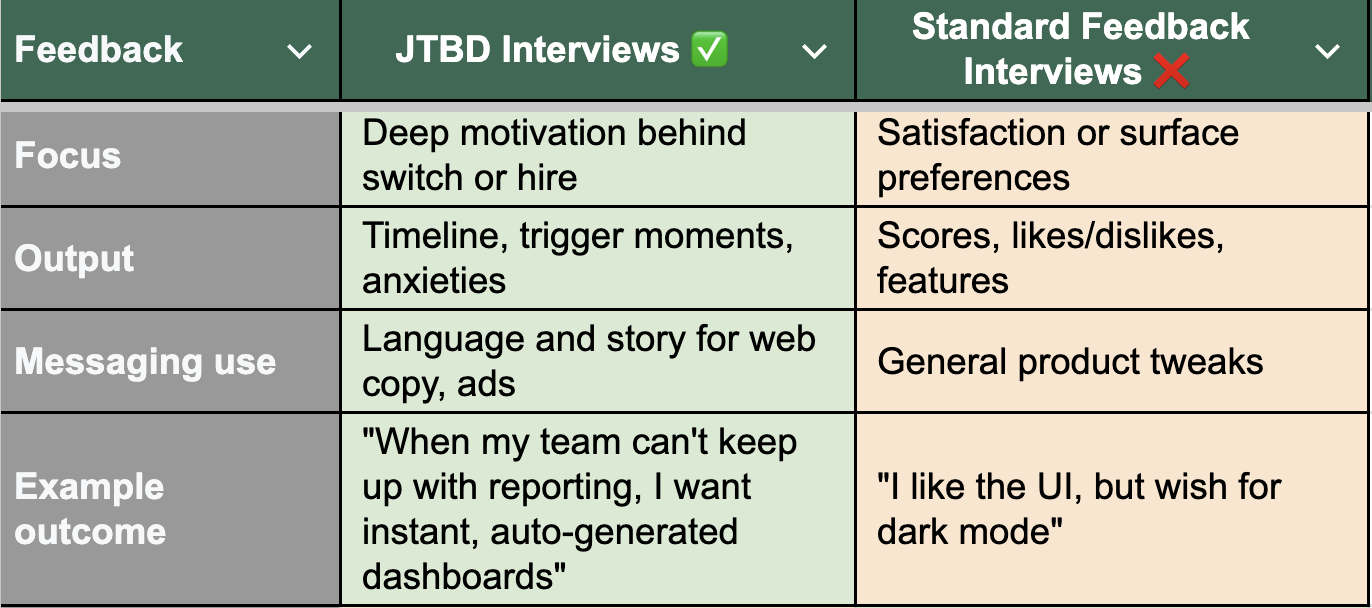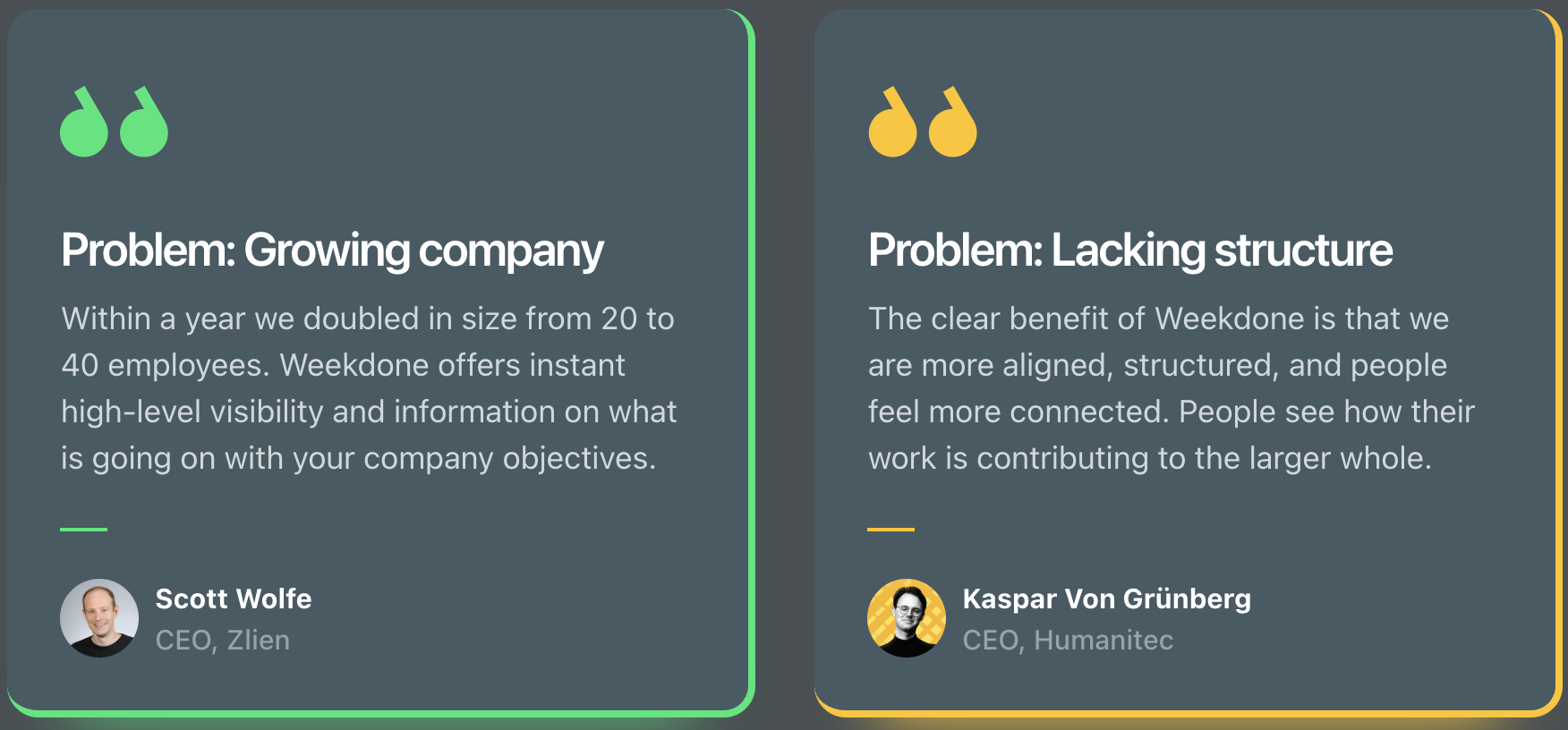Why Your Product Doesn’t Sell—Practical Messaging Tips [Templates & Examples]
99% of homepages still leave buyers asking:
Who is this for?
What does it do for me?
Why should I believe you?
Most tech teams fall into the same trap: they know their product inside out, but what feels obvious internally is foggy to everyone else.
Here’s exactly how to fix your messaging so real decision makers understand, remember, and act—backed by proven B2B methods and client lessons.
What will you find in this article?
How to guide with examples and templates on the following subjects:
Why you should use the Jobs to Be Done Method to interview your clients
Use client interviews to fix your messaging
The right order for your homepage
Your “ONLY” statement
Social proof - your messaging multiplier
Plug and play - Messaging templates
How to field test your messaging
Why I prefer the JTBD interview method
I was the Head of Marketing for a weekly status reporting and OKR software company. Not only did we have 2 products with different target groups in one software, but also about 30 use cases.
Consequently, for me as a marketeer, it was impossible to do unified marketing. Target groups, personas, messaging, copy - they were all scattered. Thus, our conversions and sales suffered.
Me and the Product manager took it upon ourselves to solve that problem with the Jobs to Be Done aka the JTBD method. The goal was to get the use cases down to 3.
We taught ourselves the JTBD method and took 1 month off from our regular duties and interviewed as many customers we could get a hold of.
It worked. We got it down to 3.
Voila, messaging improved, product roadmap got a clear focus, marketing efficiency increased and most of all - more quality leads and more customers.
1. Lead with “Jobs to Be Done” — Not Product Features
Focusing on customers’ real-world tasks is the fastest way to clarity.
Most software websites still lead with “modular, API-driven, Ai, scalable blah-blah.” Instead, start with the job your buyer is actually trying to get done.
JTBD Example Structure:
“When [situation], I want to [motivation/goal], so I can [outcome].”
Real Example (from Katana):
“From client feedback we hear that most manufacturing softwares on the market are too corporate and their customer support is slow. Now, we have put an emphasis on being as transparent as possible—showing the people behind the product and also investing heavily into customer support.”
— Oliver Vesi, Ex Katana CMO
Quick Template:
Interview recent buyers about the exact moment they started searching for a tool. (How they found your product)
Get them to describe their “old way” and what finally broke. (Situation, pain)
Ask, “What made you say, ‘now’s the time for something else’?” (Trigger)
Practical Tip:
Interview customers and steal their words for headlines and landing pages.
Example from one of my customers at Weekdone: “When our company was scaling fast, old ways of working broke down. I needed a way to set and manage our goals, so the team would be aligned, organized and focused.”
Weekdone example of JTBD interview insights displayed
2. Use Client Interviews to Fix the Message
Stop guessing what matters—ask your best customers. The fastest message tuning you can do is to conduct two 20-minute interviews with real users.
How to Do It:
Ask, “Walk me through how you solved [problem] before you found us.”
Follow up: “What changed after you started using our product?”
Pro Tip:
Use real phrases from interviews on your home page and ads. If ten customers say "stop spreadsheet chaos," use that as your copy.
Example:
“When our company was scaling fast, old ways of working broke down. I needed a way to set and manage our goals, so the team would be aligned, organized and focused.”
From this one quote you could already get a homepage message that feels real and authentic:
When you are scaling and old ways of working fail, [product] helps your team to be aligned and focused.
Now you can start telling your customers how you will fulfill this promise. Features and all the other good stuff.
3. Build Your Homepage Using the Right Order
Use this proven landing page structure:
Headline – State the outcome/relief:
“Never Lose Another Lease Renewal Again.”Subheadline – Say exactly how you help:
“Automate reminders, reporting, and compliance for busy property managers.”Visual – Show the product in action, not just people smiling.
Believability (Social Proof) – Add blunt, specific testimonials, logos, review scores.
Example:
“We now know what to track and what not to do. Before, we were buried under mountains of data. Ott helped us find the metrics that matter.” — Kristjan Kirsimäe, COO of TerminalStrong Call to Action – What, how long, and objection handler:
“Get instant setup under 5 minutes. No credit card. Personalized onboarding available.”
“ONLY” Statement Template
“We are the only platform that [does X, Y, or Z for KEY AUDIENCE] by [how you do it].”
Example:
“We are the only property management tool that automates every compliance reminder, is live in under 24 hours, and is rated 5/5 for support by real estate teams.”
4. Show Social Proof—The Messaging Multiplier
A prospect’s skepticism fades when they see real testimonials, not boasts. Decision makers trust third-party stories over promises.
What Works Best:
Short, specific quotes tied to a pain or benefit
Video testimonials or screenshots of real customer feedback
“Before and after” stories (ex: “Here’s what changed after one month”)
Winning Example:
Quick Placement Template:
One quote or logo per key landing page section
Case study snippet in every sales email
“As seen on”/review platform badges
5. Make It Plug-and-Play: Messaging Templates
Step-by-step application:
Write a headline, then run it by a non-expert (family/friend/office manager). Can they repeat it back instantly? If not, simplify.
Template Rewrite Example:
Before:
“Our modular, industry-leading SaaS platform delivers visibility and transformation in property asset workflow collaboration.”
After:
“Get your properties under control—track leases, automate reminders, finish reporting in two clicks. Trusted by property managers in 10+ countries.”
6. Field-Test: Top Three Messaging Mistakes and Fixes
Mistake: Listing features no one asked about.
Fix: Frame every feature as a solution to a real customer pain.
Mistake: Jargon overload (cloud, digital, next-gen, AI).
Fix: Use customer-originated simple language.
Mistake: No external validation.
Fix: Add logos, quotes, or short customer wins to back up your claims.
Final Checklist: Make Your Product Obvious
Interview your top 3 customers about their biggest pains and what’s changed since using you.
Rewrite your homepage/landing page with their language and actual jobs-to-be-done.
Add at least 2 relevant, authentic quotes or mini-case studies.
Remove jargon—show it to a non-expert and ask what stands out.
Make sure every claim is backed by a client story, not just your opinion.
Final words of advice
Messaging isn’t about what’s obvious to the builder. It’s about making it obviously valuable to the buyer.
Start with client language, highlight their jobs-to-be-done, and sprinkle in third-party proof for instant trust.
If your team needs a messaging tune-up, a single hour of customer interviews and onsite quote audits will do more than a month of brainstorms or clever copy writers.
Need help with interviews and messaging?
I can:
Teach you how to do it.
Learn to conduct JTBD interviews and turn them into selling messages.Do it for you.
Interview your customers and give you messaging inputs.
Sources:
https://mrx.sivoinsights.com/blog/how-to-turn-jobs-to-be-done-into-compelling-brand-messaging
https://www.linkedin.com/pulse/jobs-done-clearer-path-resonant-messaging-tebogo-mokgomogane-92ozf/
https://www.phoenixstrategy.group/blog/how-jtbd-interviews-help-scale-startups
https://willfrancis.com/8-high-converting-landing-page-examples/
https://unbounce.com/landing-page-examples/best-landing-page-examples/




